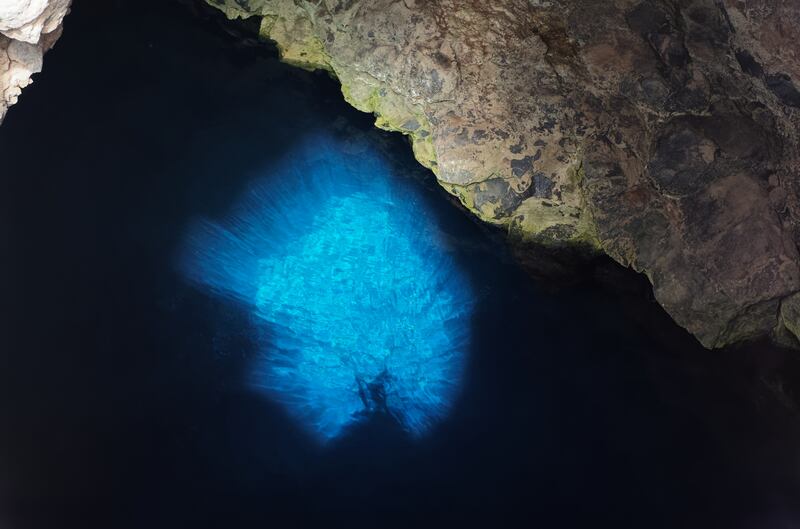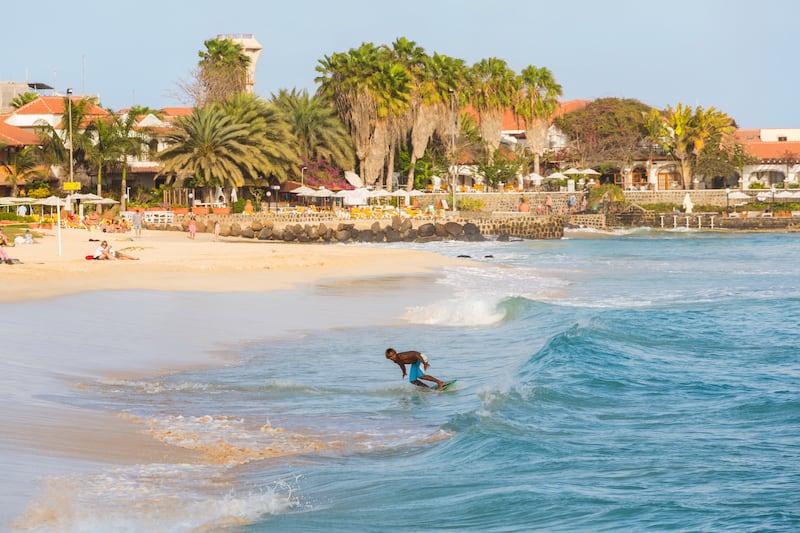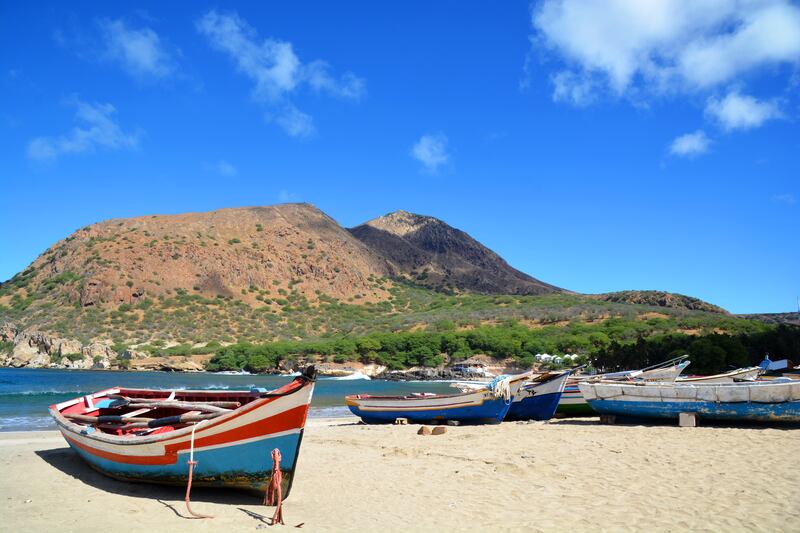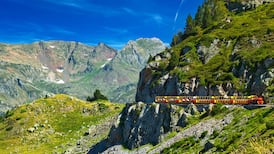The first thing you notice and feel is the wind. Strong, steady, a prevailing northwesterly that unlike Ireland is not indicative of change on the way. We are in Sal, one of a necklace of 10 volcanic islands comprising the Cape Verde archipelago, about 500km off the coast of Senegal, west Africa. Sal is the flattest and windiest, a 3½ hour flight from Lisbon, and 4½ from Brazil, so we are deep in the central Atlantic ocean. It is warm, sunny and inviting.
Independent since 1975 from the Portuguese who “discovered” the islands in the 15th century, it is stable politically and economically and, with an international airport built by Mussolini in 1939, a developing tourist destination. A friend who went on holiday for a month last year loved it so much that he stayed a further month, influencing our decision to take a short break in February. Planning it was another matter as Ireland is the only European country without direct access, so we went via Lisbon on scheduled TAP flights.
Our hotel was located 5km (a €5 taxi ride) from the town of Santa Maria fronted Algodeiro, one of 12 beaches on the island. The beach’s soft white sands transported on Elysian winds from the Sahara stretched as far as the eye could see on both sides. Its pale emerald waters were an enticing place for a pre-breakfast swim, surprisingly free of anyone else that first morning. The next day, however, the whole seafront was churning with colossal waves, a swell that on nearby Ponta Prenta, a famous beach near a headland, flushed out surfers of all kinds — kite, wind and bodyboarders. Watching them perform spectacular athletic feats and aerial acrobatics freestyling in strong wind speeds over 2 to 3m high waves was spellbinding.

A Tuscan couple, bodyboarders from Livorno, told us that one of those manoeuvring the waves was Michael Monteiro who at 12 is already a professional surfer and one of the sons of local kitesurfing legend Mitu Monteiro, a world champion who pioneered a strapless form of the sport, competes internationally as well as operating a training school on the island. Because of such wind and sea conditions, Sal is a paradise for surfers, many coming here from all over the world to practise for international championships in the winter months.
READ MORE
At the small local beach bar, lunch was freshly caught grilled grouper and salad served with rice and chips, the latter turning out to be a familiar combination on many menus. Getting there and around the place on roads that were either tarmacked, cobbled or dirt tracks meant that electric mountain bikes were useful and necessary against the strong winds and gusts and at €25 each for the day, worth it.
Another day was spent in the back of a Toyota pickup on an island tour with an informative guide/driver Emerson from MrFriendTours and photographer Ricardo Semedo. The excursion took in the country’s historic salt ponds in an extinct volcano first exploited in 1796 and operated until 1999. The water comes from deep in the earth rather than from the ocean making the salts special and along with the fun of floating suspended in its salty waters, packs of its salts can be bought in the cafe. The huge wooden cable car supports that once transported the salt and are still standing are like something out of an abandoned movie set.
Sal is also known for its turtle beaches and loggerheads are protected during the nesting and egg-laying season between July and October
Ten minutes away along a bumpy shoreside track is Shark Bay where paddling with sharks has become another visitor attraction on Sal. Local lads helped us across the rock-filled lagoon wading up to our knees into the shallow waters when the first sight of young lemon sharks circling the legs was a bit of a shock. It’s a feeding reef for these youngsters who love tropical waters. Reassuringly, older more dangerous versions are far out at sea along with whales and dolphins.
Sal is also known for its turtle beaches and loggerheads are protected during the nesting and egg-laying season between July and October. The largest nesting beach is the Costa Fragata Nature Reserve where they are protected and there are severe penalties for incursions given the degradation of the dunes due to building construction in the last 20 years; off-season there is kite surfing.

Another highlight of the day tour was Buracona and the Blue Eye cave. Located on the windswept northwest coast and accessed via a bumpy road, the cave has an opening that reveals a “blue eye” in the sunlight when its depths become an intense cerulean crystal blue. It’s great for divers, but the adjoining botanic gardens are also worth exploring showing all the various plants found all over Capo Verde while a little museum showcases the birds, flowers and geology of the islands.

One Irish couple who have made a good life and business in Santa Maria are Ciarán and Amy Keenan Molloy, who came to the island in 2005 after the UK’s Channel 4 named it as one of the top 20 locations to buy abroad. Ciarán from Portmarnock and Amy from Kilkenny had been involved in the fitness and leisure industry in Ireland but needed a change and a challenge.
After a three-week “recce mission”, they set up the first Irish bar, later sold to move to bigger premises they named The Dubliner on the town’s seafront, a thriving and lively 120-seater bar/restaurant employing 25 people. “We had never pulled a pint before we came,” Amy recalls with a laugh, adding that everything is home cooked “and we have a great Sunday lunch”.
Our hotel was one of five projects built on the island by the Resort Group, a UK hospitality resort company based in Gibraltar
It’s a hard-working life, but they love it, live in a nearby sheltered bay and their three small children who attend an international school now learn French and Portuguese. The day I visited, the place was packed, many watching the Cork-Limerick hurling final, with Ciarán busily engaged in looking after the orders. The couple also support and work with a local charity giving free scholarships to underprivileged children — for the school year 22/23, the goal was 100 scholarships “and we achieved 170 which was incredible”, says Amy.
Sal is windswept and wild, but there are other winds of change in the pipeline. Our hotel was one of five projects built on the island by the Resort Group, a UK hospitality resort company based in Gibraltar working in partnership with the international Spanish chain of Melia Hotels which runs them. The company claims that their resorts on Sal can attract more than 43,000 visitors a year; guests in our hotel were nearly all from the UK which has direct TUI flights from Bristol, Birmingham, Gatwick and Manchester. Six more developments are planned on beaches on Boa Vista, a nearby island.
Now is a great time to visit Cape Verde; the weather is best between November to May, when there is hardly any rain. September/October is the rainy season with high humidity, though temperatures of 24 degrees remain mostly the same throughout the year.
Note: TAP flights from Dublin via Lisbon can be expensive; expect to pay at least €500 return per person. Also bear in mind that arriving at Sal there is an airport tax (cash and card) of €34 per person to pay at passport control.












